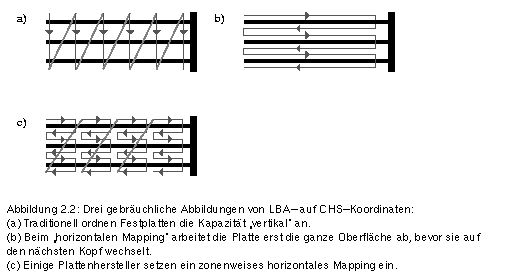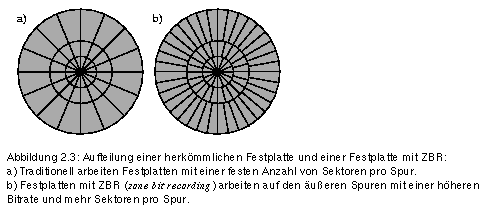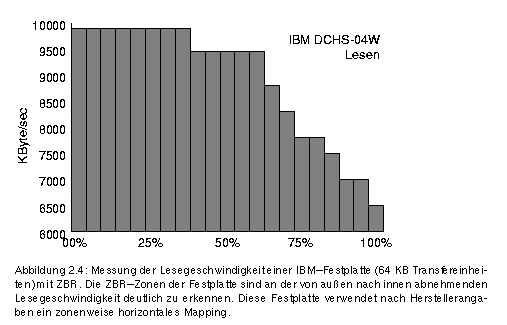Kristian Köhntop 27 Jan 2001
Track layout
On current hardware, track layout is the resonsibility
of the harddisk, and it is extremely hard to get the actual
physical mapping from the disk, due to things to ZBR and
other issues. There were a number of very good articles
in the c't magazine on this, with interesting measurements.
I have attached to this article a number of illustrations
from chapter 2 of my thesis, from
node5 and
node6 (note
that the images are only available in the
postscript version for technical reasons).

Image 2.2
Image 2.2 shows three possible conversions from LBA to CHS
coordinates. Traditional conversion is a), vertically. That
is, cylinders are written, from the outside to the inside of
the disk, low cylinder numbers are on the outside (see image
2.4 for more information) of the platter.
Some disks have dynamic tracking, though, and for these it
is slower to change platters than to reposition on the same
platter. These disks use the conversion schema in b).
Also, very few disks have a complex mapping as shown in c),
noteably some notebook harddisks from the 1996 area use this.
Harald Bögeholz has measured these disks in his article series
"Disk carousel" cited above, and shows nicely how you need to
measure each model in order to determine reliable performance
data. He also had some defective disks, which exposed even more
information about their internal organization. I do not have
these magazines any more, but I bet service@heise.de is willing
to send you paper copies of them or get you in touch with
Harald Bögeholz.

Image 2.3
Image 2.3 illustrates how ZBR is responsible for different speeds
and why outer cylinders are faster than inner cylinders.

Image 2.4
Image 2.4 shows speed zones on an IBM DHCS-04W (read performance
shown). Low cylinder numbers are faster, therefore they are
on the outside. Also, this disk has a mapping like 2.2a) indicates.
A 2.2b) mapping would generate a triangular wave in a speed
measurement, with one peak for each platter. 2.2c) would generate
a pattern similar to 2.2a), but tries to mask part of the
speed decline.
Bibliography
Bo95a
Bögeholz, Schneider, Schnurer, "Byte Milliardäre; Moderne
Festplatten mit SCSI- und IDE-Interface," c`t, Magazin für
Computertechnik, Heise, Hannover, Juni 1995, Seite 120 ff.
Bo95b
Harald Bögeholz, "Platten-Karussell; Aktuelle Festplatten im
Vergleich," c`t, Magazin für Computertechnik, Heise, Hannover, November 1995,
Seite 114 ff.
Bo96a
Harald Bögeholz, "Platten-Karussell; Festplatten mit EIDE- und
SCSI-Schnittstelle im Überblick," c`t, Magazin für Computertechnik, Heise,
Hannover, April 1996, Seite 268 ff.
Bo96b
Harald Bögeholz, "Platten-Karussell; Festplatten mit EIDE- und
SCSI-Schnittstelle im Überblick," c`t, Magazin für
Computertechnik, Heise, Hannover, September 1996, Seite 272 ff.



